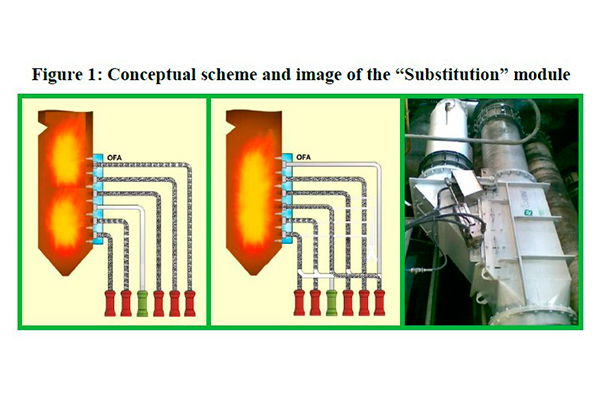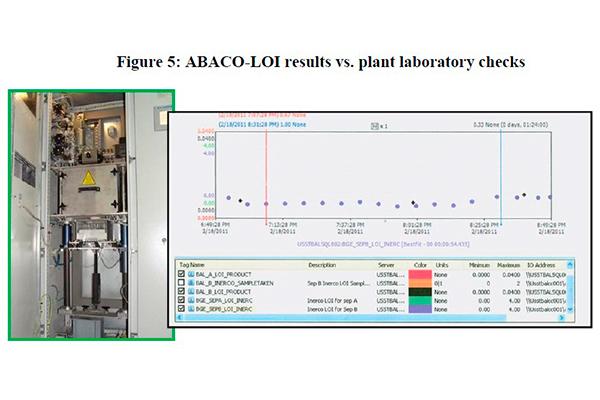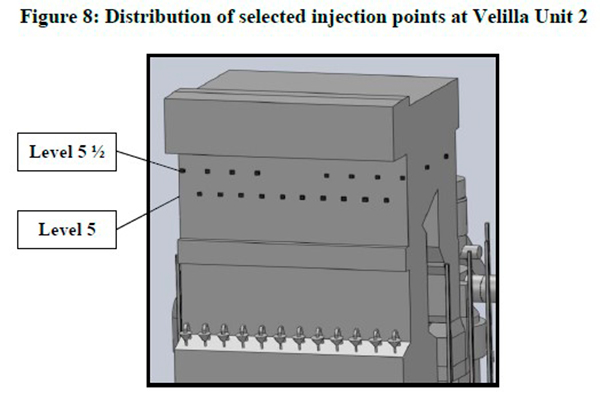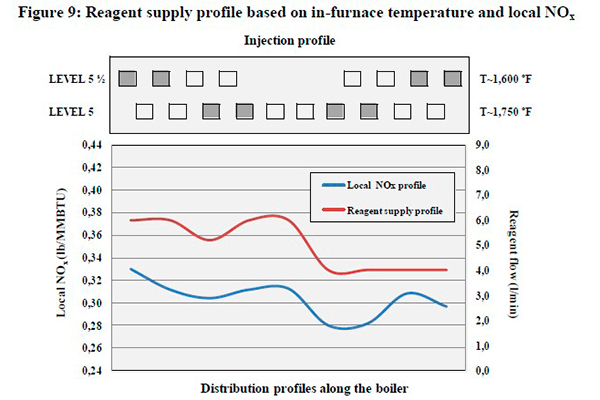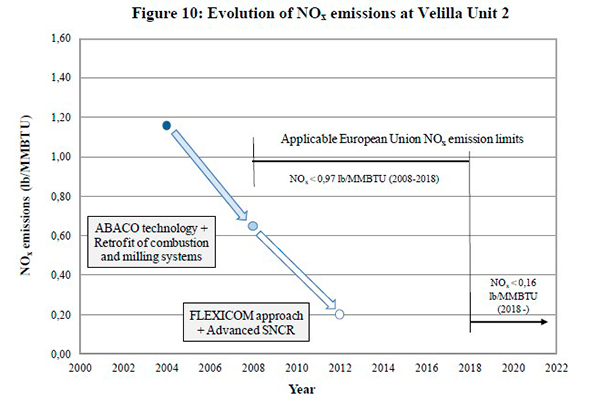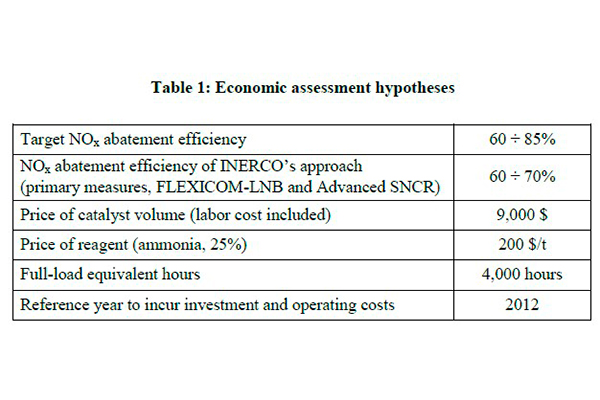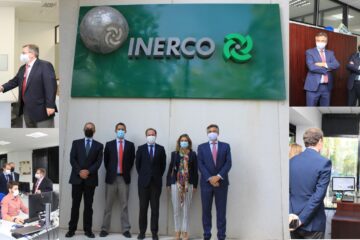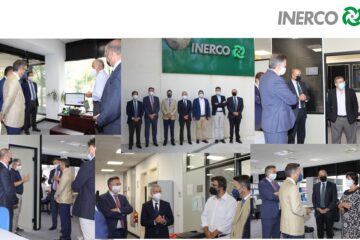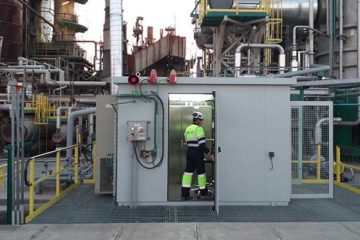Paper presented at 2012 Power Plan Air Pollutant control “MEGA” Symposium
ABSTRACT
Power sector is currently seeking for the cost-effective minimization of NOx emissions. This demanding challenge has been met by INERCO through a technological approach successfully applied in a European coal-fired power plant, whose scope and results are hereinafter described.
Firstly, advanced combustion technologies lead to a maximum intensification of fuel and air staging strategies for any operating scenario. A tight control over combustion by the accurate monitoring of in-furnace gas concentrations and LOI is crucial to meet this objective. Secondly, this approach entails the synergic integration of these technologies with NOx abatement solutions alternative to conventional catalytic technologies.
This customized combination of advanced technologies has resulted in an alternative solution to SCR technology, leading to 30%-50% reductions in capital costs for the case study described. Otherwise, when applied to existing SCR units, the significant NOx reductions achieved yield significant savings in operating costs, typically ranging from 40% to 60%.
INTRODUCTION
Increasingly stringent worldwide environmental legislation is requiring the coal power sector to install high-efficiency abatement technologies to comply with pollutant emission limits imposed by the applicable national standards. At the same time, the industrial sector is also required to take into account profitability criteria, not only in the decision-making process of undertaking retrofit actions in their facilities, but also in their day-to-day operation to minimize current operating costs.
The regulation of nitrogen oxide (NOx) is becoming particularly severe worldwide. In order to meet the imposed emission limits, the exclusive application of primary measures (combustion control), such as combustion tuning, low-NOx burners and over fire air (OFA) systems, have proven to be insufficient under most circumstances. Among the commercially available post-combustion (secondary measures) NOx abatement systems, Selective Catalytic Reduction (SCR) systems are the most appropriate and widely used technology to reach the high reduction efficiencies required. However, the installation or use of conventional SCR solutions in existing combustion facilities has technical and economic drawbacks.
First, the installation of a separate SCR system reactor is technically difficult in most existing facilities due to the lack of available space to undertake such a significant retrofit action. Besides, this solution might not be optimized from an economic viewpoint, as it leads to extremely high investment costs that would seriously jeopardize the profitability of the facilities, bringing serious difficulties to amortize the investment, especially in those power plants with a short remaining lifetime. Also, it entails high annual operating costs and a loss of efficiency that affects plant profitability.
Second, in those facilities where SCR systems are already installed, their significant operating costs bring about a pressing need to optimize their performance through the reduction of reagent consumption or the improvement of catalyst management. Considering current power plant operating trends, characterized by frequent start-ups and shut-downs and increasingly long part-load operating periods, the lack of flexibility shown by SCR systems makes it even more difficult to justify the investment and operating costs required to achieve the target NOx emissions limits.
Facing this complex scenario, characterized by the lack of technological alternatives to SCR systems, INERCO has developed a methodology and technical approach based on the customizable combination of advanced primary and secondary measures for the reliable and cost-effective minimization of NOx emissions in any operating scenario. Consequently, it constitutes a cost-effective alternative to new SCR systems due to the considerable savings in investments costs combined with an effective complementary solution to existing SCR systems, and is able to produce remarkable reductions in operating costs.
This paper is focused on the description of the novel technological solutions conceived by INERCO and the depiction of a representative case study detailing the successful results achieved at a coal-fired power plant owned by IBERDROLA, the main Spanish power generating company and one of the top electric utilities worldwide. The approach developed by INERCO was applied in this facility and based on the results it was possible to carry out an economic comparative assessment between this approach and the use of conventional SCR technologies.
TECHNICAL APPROACH
The integrated approach developed by INERCO relies on a synergic combination of advanced primary and secondary measures. The purpose of the proposed primary measures is to achieve minimum NOx emissions compatible with combustion control and process safety through the optimization of the coal distribution to the boiler. Starting from a safe low NOx operating condition, the INERCO approach consists of tailor-made integration of proprietary DeNOx solutions with advanced capabilities to achieve optimum results in large-sized boilers.
Advanced primary measures
The INERCO approach is targeted to minimize NOx generation while achieving optimum combustion conditions for any operating scenario by the implementation of innovative regulation capabilities. This advanced combustion regulation is fully-complementary with other conventional primary measures applied by INERCO, such as over-fire air (OFA), burner upgrades, fuel reburning or mill classifier retrofits. In addition, this approach is enhanced by incorporating improved combustion control based on proprietary state-of-the-art monitoring tools that have been widely demonstrated by INERCO.
Optimum firing distribution with an increased flexibility
Optimized operating strategies are essentially based on achieving maximum stratification of coal and air supplies to the boiler. However, the actual applicability of these strategies is hampered by two main factors. First, the appearance of operating problems, such as increased carbon-in-ash or efficiency losses. Second, the impossibility of maintaining the most favourable coal and air distribution, due to necessary maintenance actions on the milling systems, which leads to increased NOx emissions, carbon-in-ash or furnace temperatures.
These limitations are overcome by the novel FLEXICOM-LNB technology, which enables the adoption and steady maintenance of optimal in-furnace firing distribution for any operating scenario (boiler load, milling system arrangement, fuel quality). This is based on the retrofit of the coal distribution system with two advanced regulation systems:
Substitution System – steady air and fuel supply irrespective of mills in service, which avoids unwanted scenarios promoted by mill unavailability (“burner gaps”), which produce increased NOx emissions and carbon-in-ash. This also allows the strict fulfillment of the mill maintenance programs scheduled by the utility (Figure 1).
- Addition System – minimum NOx generation by the achievement of maximum fuel stratification and coal residence time, without increasing mill production and, therefore, without penalizing coal fineness, which favors the minimization of CO emissions and the control of unburned carbon-in-ash (Figure 2).
The combination of both systems avoids shifting the combustion process to the upper furnace region as it happens for high performance over-fire air (OFA) solutions, resulting in a more effective way to control furnace temperatures and desuperheater spray flow rates. Consequently, besides the minimization of NOx emissions for all operating scenarios, the beneficial features of FLEXICOM-LNB lead to the optimization of boiler efficiency and heat rate and the avoidance of collateral operating problems (carbon-in-ash, corrosion, etc.).
The FLEXICOM-LNB approach has been validated in a number of coal-fired power plants. Full integration with advanced monitoring tools was achieved in a 580 MWe tangential boiler. As a result, it was possible to reach NOx emissions reductions ranging from 35% to 45% for a wide range of operating conditions:
- Unit load: MCR, medium load (66% MCR) and MSG (30% MCR).
- Coal composition: diverse bituminous coals with variable contents in moisture, ash, volatile matter and nitrogen.
- Milling system arrangement, including unfavorable scenarios with upper mills in service.
Besides the NOx reductions achieved, combustion performance was also extensively monitored by following diverse parameters. Thus, the sale of ash to the cement industry was guaranteed by an steady fulfillment of the most severe unburned carbon-in-ash limits, without penalizing boiler efficiency (in specific cases, it was improved up to a maximum value of 0.6%), and without negative influence on steam cycle parameters.
Advanced monitoring of combustion process
The possibility of taking full advantage of the FLEXICOM-LNB technology and other conventional primary measures relies on the combustion control achieved by the use of advanced monitoring tools, which are mainly focused on the measurement of local in-furnace combustions conditions and unburned carbon-in-ash. The achievement of optimized combustion scenarios is based on the characterization of actual in-furnace combustion conditions using the ABACO-Opticom technology. This monitoring technology makes it possible to achieve tight control of the combustion process through the direct measurement of gas concentration profiles (O2, CO, CO2, NOx, SO2) on the envelope of each fuel and air stream entering the combustion chamber and near the furnace walls (Figure 3).
To illustrate the potential of this approach, Figure 4 shows three different operating scenarios in a front-wall coal-fired boiler characterized by the individual coal supplies to burners measured and the gas profiles obtained through ABACO-Opticom: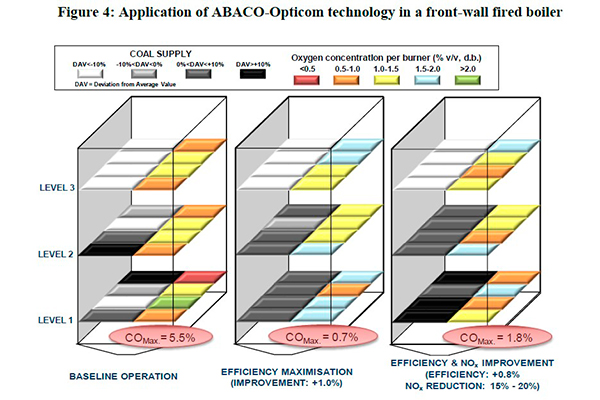
- Baseline operation: this shows significant imbalances in the coal supply and in-furnace O2 concentrations.
- Optimized efficiency scenario: where balancing the coal supply has led to an increased efficiency of 1.0%.
- Operating scenario seeking a combined optimization of efficiency and NOx reduction: this has produced up to 20% NOx reductions and heat rate improvements around 0.8% by the balancing and staging of the coal supply.
The optimized control reduces potential boiler corrosion problems by avoiding extremely low O2 concentrations at the boiler walls.
In addition, adequate measurement of unburned carbon-in-ash or Loss on Ignition (LOI) in coal-fired boilers is an issue of utmost importance for optimizing boiler operation. This parameter has direct influence on efficiency and establishes a targeted boiler tuning limit for NOx minimization. Monitoring carbon-in-ash is also necessary for the surveillance of ash quality for its sale to the cement industry.
The automated monitoring of carbon-in-ash is accomplished by using the ABACO-LOI monitoring system, which is unique industrial equipment based on the application of laboratory reference techniques used for the characterization of fly-ash. This system does not need to be recalibrated even if the physical-chemical properties of coals or ash vary. As an example, the application of ABACO-LOI at a US power plant provides maximum accuracy and reliability with perfect adjustment to the dynamics of the installed application.
Figure 5 shows the LOI signal produced by ABACO-LOI (purple circle) and the representation of periodic laboratory results produced in accordance with procedures for controlling the quality of the product ash (black diamond). The overall results show a very tight alignment to the dynamics of the plant, with associated standard errors below 0.2%. Although these results have been obtained for high monitoring demand (over 8,000 measurements per month), no drift in the results have been observed, which shows the reliability of the system.
Secondary measures: Advanced SNCR technology
In order to minimize NOx emissions under a cost-effective approach, INERCO has developed a non-catalytic abatement technology which, combined with the primary measures previously described, is able to become either an alternative or an effective complement to existing SCR systems.
In general, the maximum potential of non-catalytic secondary measures, such as selective non-catalytic reduction (SNCR) systems, has been demonstrated in small industrial and power boilers. However, the reduction efficiency achieved in larger coal-fired power units has been low, mainly due to the boiler size (reagent penetration into the flue gas) and the difficulties in identifying optimum temperature windows with variable operating scenarios. The following are the key performance parameters in the SNCR process:
- Temperature – O2 and CO concentrations define the operating temperature window where the NOx reduction reactions occur at high efficiency rates.
- NOx profiles – NOx profiles are produced in the combustion zone based on the specific design of the boilers. However, these profiles are non-uniform and not constant over time due to the dynamics linked to the combustion process. Precise knowledge of the NOx content in the injection zones is needed to achieve optimized injection of the correct reagent quantity per injection port.
The approach designed by INERCO is intended to meet these parameters by achieving highly flexible reagent injection in the most suitable furnace areas. The availability of the INERCO advanced in-furnace monitoring capabilities provides the temperature profile and composition (NOx, O2 and CO) upstream of the injection zone to assure optimized injection profiles based on the individual control of reagent injection in each lance. This optimized injection approach brings two direct benefits: higher NOx reduction rates compared with conventional applications and effective control of ammonia slip.
This approach has been validated by INERCO using its proprietary Advanced SNCR demonstration plant (Figure 6), which is characterized by increased flexibility and adaptability to different scenarios as follows:
- Adaptability to large-sized boilers with power outputs of up to 600 MWe.
- Modular design that is easily adapted to any combustion facility and type of boiler.
- Possibility to employ different reagents, such as ammonia or urea, with fully adjustable levels of dilution.
- Applicability of a novel NOx abatement technique called Double Temperature Window SNCR (DTW SNCR), to inject ammonia-based reagents in both medium-temperature and high-temperature furnace locations.
- Individual tuning of injection lances to achieve a differential reagent supply in different furnace zones.
- Lances especially designed to optimize the mixture of the reagent and the flue gas, covering wide furnace areas.
- Easy integration with any NOx reduction technology and high synergy with in-furnace monitoring technologies.
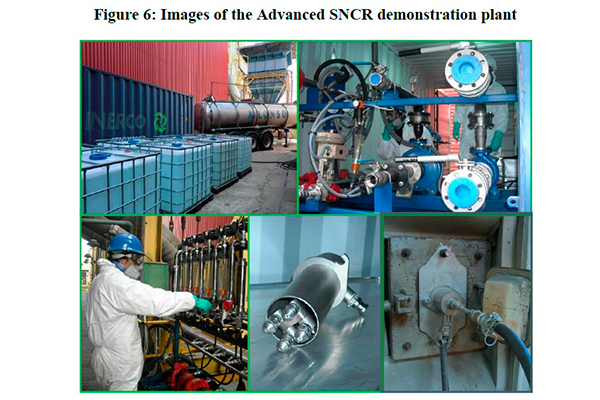
CASE STUDY: VELILLA UNIT 2 (IBERDROLA)
INERCO and IBERDROLA have closely collaborated for over a decade in the optimization of combustion process in coal-fired power plants. This collaboration has been strengthened up to the recent joint demonstration of an integrated approach which includes the different technologies previously described. The scope of this approach and results achieved throughout the collaboration is described below.
Characterization of the hosting power plant
Velilla Unit 2 is a power plant owned by IBERDROLA in which INERCO has implemented and validated the vast majority of its proprietary technologies. Velilla Unit 2 has a 350 MWe arch-fired boiler with 24 burners which burn a blend of national anthracite and imported bituminous coal (Figure 7). This type of boilers is designed to reach high temperatures to promote the burnout of the anthracite, which is characterized by its low reactivity. Consequently, this combination of boiler design and coal leads to extremely high NOx emissions, typically ranging between 1.3 and 1.8 lb/MMBTU depending on the nitrogen content of the anthracite and the specific operating conditions of the facility.
Technological approach at Velilla Unit 2
The wide technological approach implemented and successfully validated by INERCO at Velilla Unit 2 throughout the last decade was carried out in three main phases.
- Implementation of ABACO technology
After the development of different testing campaigns at Velilla Unit 2, it was decided to implement the ABACO combustion optimization system, with the following scope:
- ABACO-Opticom system for the advanced in-furnace monitoring of gas concentrations (O2, CO, CO2, NO) above each burner, by means of 24 water-cooled sampling probes.
- ABACO-LOI, for the automated sampling of fly-ash from the ESP and the subsequent characterization of carbon-in-ash by determining the Loss on Ignition (LOI).
- Retrofit of regulation capabilities for primary air/coal mixtures:
- Installation and automation of coal dampers for the automated control of pulverized coal supplies to individual burners (ABACO-Coal).
- Automation of the most relevant secondary air regulation systems.
- Integration of the selected new and existing monitoring and regulation systems within the ABACO Combustion Control Expert System for the optimized closed-loop control of combustion process.
- Improvement of combustion regulation capabilities
- Optimization of milling system: installation of regulating devices in all mill classifiers, so as to convert them into adjustable classifiers, with wide capability to improve the particle size distribution of pulverized coal.
- Retrofit of combustion air regulation capabilities in all the burners to achieve an improved stratification of combustion air, including:
– Windbox modification: retrofit of secondary and tertiary air regulation systems.
– Construction of OFA ducts and dampers for each burner.
– Retrofit of burner cyclones to achieve an improved stratification of coal supply.
- Validation of FLEXICOM-LNB approach by the specific implementation of appropriate operating scenarios.
- Demonstration of Advanced SNCR technology
In order to validate the novel NOx abatement technology conceived by INERCO, the following approach has been recently implemented at Velilla Unit 2:
- Installation of the Advanced SNCR Demonstration plant adapted to the injection of urea or ammonia in up to 8 injection points simultaneously. These injection points have been selected in three different furnace areas based on the existing temperature (Figure 8).
- Implementation of a complementary monitoring approach consisting of:
– In-furnace temperature monitoring through optical pyrometers and High Velocity Thermocouple (HVT) probes.
– In-furnace manual measurement of gas concentrations (O2, CO, CO2, NO) in additional points to those monitored by ABACO-Opticom.
– In-situ ammonia slip monitoring through a laser-based gas analyser.
This approach has enabled the individual regulation of reagent per injection lance, leading to optimized reagent supply strategies as those shown in Figure 9, which are based on local NOx concentrations and temperature.
Results
Figure 10 shows the historic change in NOx emissions generation at Velilla Unit 2 over the last decade since the beginning of the collaboration between IBERDROLA and INERCO. This figure also depicts the NOx emission limits imposed by the applicable environmental legislation throughout this period, which was limitless up to 2008:
- The implementation of the ABACO technology resulted in significant NOx reductions up to values around 1.16 lb/MMBTU, which is far below the initial emission limit considered by the European legislation. In addition, the heat rate of Velilla Unit 2 was improved by 1.0% while strictly keeping carbon-in-ash below 7%, the limit imposed to assure the saleability of the ash to the cement sector.
- The retrofit of the milling and combustion systems in combination with the ABACO technology provided extraordinary results: 44% NOx reductions to values below 0.65 lb/MMBTU. Heat rate reductions were also achieved with an accumulated improvement of 1.5% relative to the historic baseline, with the unburned carbon-in-ash values kept below the limit 7% required.
- By conducting more than 130 injection tests INERCO was able to demonstrate the feasibility of its global DeNOx approach at Velilla Unit 2, with the following results:
– Additional NOx reductions ranging from 40% to 50% when adding the Advanced SNCR technology to the optimized scenarios previously identified.
– The application of this approach together with the implementation of operating scenarios based on FLEXICOM-LNB approach led to NOx emissions around 0.20 lb/MMBTU, which was an 83% reduction relative to the initial results achieved and final NOx emissions near the limit imposed by the European environmental legislation for this power unit by 2018.
– The resulting NOx reductions have been achieved while holding sustainable ammonia slip values around 5 ppmv. Although these results are satisfactory, the scheduled installation of a slip catalyst would give rise to lower ammonia slip, while achieving further NOx reductions.
ECONOMIC ASSESSMENT
In order to perform an economic assessment of the technological approach developed by INERCO in comparison with the application of SCR technology it was necessary to establish several hypotheses to make an accurate and comparable estimate of investment and operating costs (Table 1).
When an SCR system is not available in the target power facility the comparative assessment should focus on the investment costs to reach the required NOx emissions. The approach to be implemented would vary based on the specific characteristics of each combustion facility. In certain cases, the exclusive application of optimized primary measures and SNCR may not be enough to achieve the highest NOx reduction rates. Therefore, the scope of the approach should be widened by applying additional NOx reduction techniques, such as reburning, high-temperature reagent injection or non-conventional catalytic technologies.
Assuming a target NOx reduction efficiency ranging from 60% to 85%, the comparative assessment between SCR and other alternative approaches leads to significant capital costs reductions, as shown in Figure 11. Considering a required 60% NOx reduction, the approach proposed by INERCO would fulfill the requirements with associated capital costs reductions of over 50% compared with conventional SCR approaches. In this case, the investment cost of the SCR system considered is 85 $/kW, and for the optimized approach 30-40 $/kW.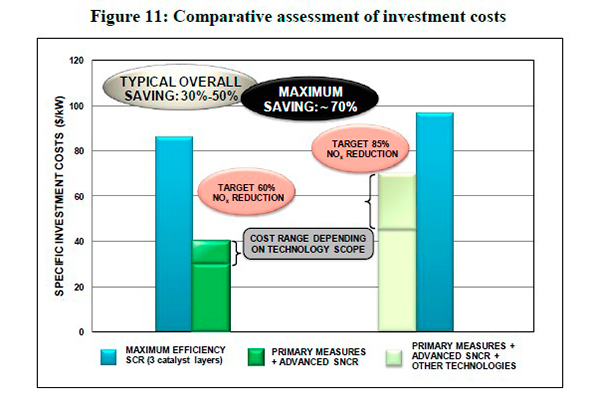
If an 85% NOx reduction is required, additional technologies to FLEXICOM-LNB and Advanced SNCR have to be considered. Capital costs associated with the SCR system are around $95/kW and the investment costs for the implementation of the additional technologies are in the range of $15-$30/kW. Then, the total costs of INERCO approach are $45-$70/kW depending on the required retrofit. When extrapolating this assessment to other representative operating scenarios, it can be concluded that the savings in investment costs would typically vary from 30% to 50%. However, in some particular scenarios this saving can be increased up to values around 70%.
The economic assessment developed has been extended to the case in which an SCR system is already available and therefore, the economic analysis should target a comparison of operating costs to reach a precise NOx reduction efficiency. Two different cases are considered:
- Conventional case: conventional primary measures and exclusive performance of the SCR system with maximum abatement potential.
- Optimized case: joint application of advanced primary measures including FLEXICOM-LNB and the SCR system with reduced scope (e.g. reduction of one catalyst layer).
Assuming a target NOx reduction efficiency of 80%, the results achieved when comparing these cases show a 62% reduction in ammonia consumption and a 20% reduction in catalyst volume. Therefore, the operating costs linked to reagent and catalyst savings are reduced from $620 to $330 per ton of abated NOx. These results are clearly shown in Figure 12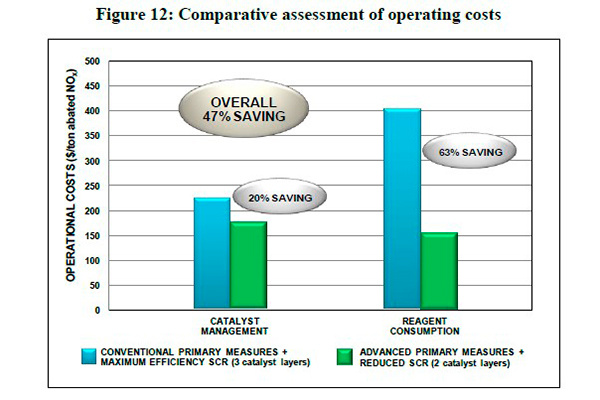
This analysis has been extrapolated to other representative scenarios, which establishes typical operating cost savings ranging from 40% to 60% when installing advanced primary measures based on the FLEXICOM-LNB technology. The savings achieved result in Return-on-Investment (ROI) periods as low as 1-2 years, based on the specific conditions of each facility. The catalyst replacement cost was not considered in this analysis because is highly dependent on the outage flexibility of the plant. Still additional savings should be considered for this reason.
SUMMARY
The challenge of achieving NOx emission limits imposed by environmental legislation, while preserving the profitability of industrial combustion facilities, requires a careful analysis to implement an optimized approach. Some generating companies may decide to only install conventional catalytic solutions (SCR), which is the most reliable technology to reach the most stringent NOx emissions levels. Although this may be the most straight-forward technological alternative, it is definitely not the most cost-effective solution.
INERCO has developed a state-of-the-art approach based on the joint integration of advanced customizable primary and secondary measures. This approach relies on novel tools, such as FLEXICOM-LNB technology, conceived to take full advantage of coal supply profiles under the enhanced control provided by cutting-edge monitoring technologies already demonstrated by INERCO. In addition, this approach incorporates an Advanced SNCR technology specifically designed to achieve maximum NOx abatement efficiencies in large-sized boilers. Both solutions are highly complementary, as they can be easily integrated by applying INERCO advanced in-furnace monitoring technologies.
This integral approach has been validated at Velilla Unit 2, a coal-fired power plant owned by IBERDROLA, one of the main electric utilities worldwide. The broad experience gathered in this facility over the last decade and the development of a comprehensive testing campaign integrating all the technologies developed by INERCO has resulted in the achievement of highly remarkable results: over 80% NOx abatement efficiencies while avoiding collateral problems, such as excessive ammonia slip or penalties in carbon-in-ash, boiler efficiency or steam temperatures.
The economic assessment developed shows how this innovative approach can be considered as an alternative solution to conventional catalytic solutions based on the reduced investment costs achieved, typically ranging from 30% to 50%, with maximum savings around 70% for particular operating scenarios. In addition, it may also be a valuable complement to SCR technology due to the reduction in operating costs, generally varying from 40% to 60%.
ACKNOWLEDGEMENTS
The authors gratefully acknowledge the collaboration of other personnel involved in the activities described. Special thanks are given to the technical staff of IBERDROLA and INERCO. These developments have been co-financed by FEDER funds (European Union).
Francisco Rodriguez Barea
Enrique Tova
Enrique Bosch
John W. Sale
Andoni Redondo


